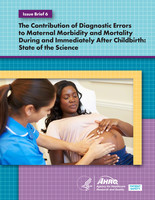| October 5, 2021, Issue #783 Emergency department visits for dental-related conditions totaled more than 2 million in 2018. The highest rates of visits were among non-Hispanic Black individuals (1,362 per 100,000 population), people ages 18 to 44 (1,107), and those living in the lowest-income communities (1,069). (Source: AHRQ, Healthcare Cost and Utilization Project Statistical Brief #280: Emergency Department Visits Involving Dental Conditions, 2018.) Access more data on this topic in the associated statistical brief, plus additional AHRQ data infographics.  In two publications from an AHRQ grant, researchers found that changes to drug labels could help reduce adverse drug reactions in older adults. In the first, published in the Journal of the American Pharmacists Association, 318 pharmacists surveyed agreed that patients are more likely to pay attention to an over-the-counter drug's purpose, directions, active ingredients and warnings if they are listed on the front drug facts label. They concluded that moving these elements to the front of the bottle can help older adults make safer purchasing decisions, potentially reducing adverse events. The second, in Cognitive Research: Principles and Implications, asked 60 volunteers to detect and identify drug label changes on a unique drug facts warning label design. Their speed and accuracy in detecting label changes increased significantly (nearly one second and more than 23 percentage points, respectively) when changed information was highlighted, presented on the front of the package or duplicated on the novel label. | Health insurance offered by private-sector employers was characterized by stability in both premiums and cost sharing for covered workers in 2020, according to a newly released statistical brief based on data from AHRQ's Medical Expenditure Panel Survey (MEPS). Health insurance premiums for private-sector employees with single coverage increased by 2.5 percent from 2019 to 2020, while showing no significant change for employee-plus-one and family coverage. Average health insurance premiums in 2020 were $7,149 for single coverage, $14,191 for employee-plus-one coverage, and $20,758 for family coverage. Employee contributions for health insurance averaged $1,532 for single coverage, $4,035 for employee-plus-one coverage, and $5,978 for family coverage. MEPS data also show deductible levels for individual and family coverage in 2020 were not statistically different from 2019. A new AHRQ grant opportunity is available to help make healthcare safer in ambulatory care and long-term care settings. The focus is on implementing evidence-based processes to improve patient safety, especially those involving transitions in care. These projects will increase knowledge of how to best integrate measures, metrics, tools and practices to prevent adverse events. Issues in underserved and vulnerable populations will be a focus. Proposals are due January 25. AHRQ's Patient Safety Network (PSNet) highlights journal articles, books and tools related to patient safety. Articles featured this week include: Review additional new publications in PSNet's current issue or access recent cases and commentaries in AHRQ's WebM&M (Morbidity and Mortality Rounds on the Web).  Emerging evidence suggests that diagnostic error may play a role in severe maternal morbidity and maternal mortality, according to a new AHRQ Issue Brief. Maternal mortality continues to be a public health crisis, with 20 to 80 percent of deaths considered preventable. The Issue Brief's authors outline how to address delays in recognizing risk factors and escalating emergency obstetric care. They identify gaps in the diagnostic process and opportunities for improvement, and outline the research agenda needed to make progress in this emerging area. Access The Contribution of Diagnostic Errors to Maternal Morbidity and Mortality During and Immediately After Childbirth: State of the Science. | | AHRQ in the Professional Literature Patient characteristics associated with the successful transition to virtual care: lessons learned from the first million patients. Zachrison KS, Yan Z, Sequist T, et al. J Telemed Telecare. 2021 Jun 13. [Epub ahead of print.] Access the abstract on PubMed®. Monitoring diagnostic safety risks in emergency departments: protocol for a machine learning study. Enayati M, Sir M, Zhang X, et al. JMIR Res Protoc. 2021 Jun 14;10(6):e24642. Access the abstract on PubMed®. Variation in rates of hospital admission from the emergency department among Medicare patients at the regional, hospital, and physician levels. Smulowitz PB, O'Malley AJ, McWilliams JM, et al. Ann Emerg Med. 2021 Oct;78(4):474-83. Epub 2021 Jun 18. Access the abstract on PubMed®. Using a customer relationship management system to manage a quality improvement intervention. Pham-Singer H, Onakomaiya M, Cuthel A, et al. Am J Med Qual. 2021 Jul-Aug;36(4):247-54. Access the abstract on PubMed®. Racial disparities exist in surgical outcomes for patients with inflammatory bowel disease. Dos Santos Marques IC, Theiss LM, Wood LN, et al. Am J Surg. 2021 Apr;221(4):668-74. Epub 2020 Dec 7. Access the abstract on PubMed®. Using change detection to objectively evaluate whether novel over-the-counter drug labels can increase attention to critical health information among older adults. Harben AL, Kashy DA, Esfahanian S, et al. Cogn Res Princ Implic. 2021 May 26;6(1):40. Access the abstract on PubMed®. Artificial intelligence techniques that may be applied to primary care data to facilitate earlier diagnosis of cancer: systematic review. Jones OT, Calanzani N, Saji S, et al. J Med Internet Res. 2021 Mar 3;23(3):e23483. Access the abstract on PubMed®. Medicaid's EPSDT benefit: an opportunity to improve pediatric screening for social determinants of health. Malhotra NA, Nevar A, Yearby R, et al. Med Care Res Rev. 2021 Apr;78(2):87-102. Epub 2019 Sep 15. Access the abstract on PubMed®. Contact Information For comments or questions about AHRQ News Now, contact Bruce Seeman, (301) 427-1998 or Bruce.Seeman@ahrq.hhs.gov. |




No comments:
Post a Comment